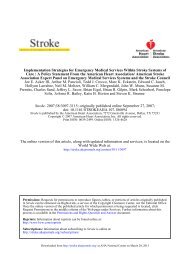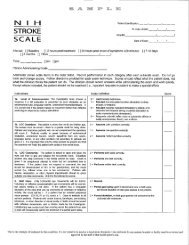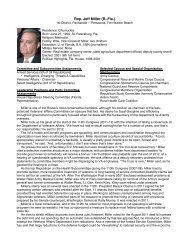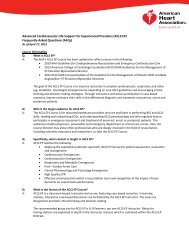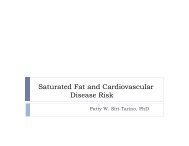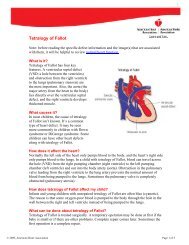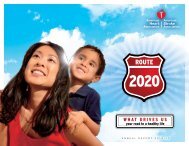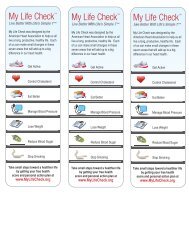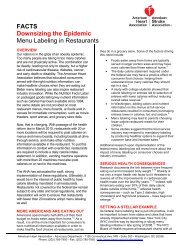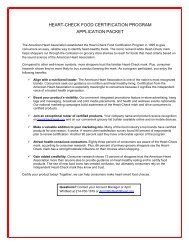HEART MONITOR MATH - American Heart Association
HEART MONITOR MATH - American Heart Association
HEART MONITOR MATH - American Heart Association
Create successful ePaper yourself
Turn your PDF publications into a flip-book with our unique Google optimized e-Paper software.
<strong>HEART</strong> <strong>MONITOR</strong> <strong>MATH</strong><br />
PAGE 1 of 3<br />
Description: Students will be divided into groups and will monitor their heart rates and determine which<br />
exercise is best for exercising their hearts.<br />
Learning Objectives:<br />
• Students will use their multiplication skills.<br />
• Students will practice collecting data and making conclusions.<br />
• Students will learn the correlation between exercise and a healthy lifestyle.<br />
Activity Time: 45 – 60 minutes<br />
Materials:<br />
Each group of students will need:<br />
Directions:<br />
• Stopwatch<br />
• Pens or pencils<br />
• <strong>Heart</strong> Monitor Math worksheet (page 3 of 3)<br />
• Open space (gymnasium, field, auditorium or cafeteria)<br />
• Distribute a <strong>Heart</strong> Monitor Math worksheet to each student.<br />
• Tell the class that they will be using different formulas to measure their heart<br />
rates. Explain why it is important to know how to measure your heart rate<br />
(good exercise level, good health, avoid overexertion, etc.)<br />
and let them know the normal resting heart rate for children,<br />
which is 70-100 beats per minute for ages 6 – 15.<br />
• Have students measure their resting heart rates. (See the Keep Moving!<br />
worksheet found after the last activity sheet to learn the proper way<br />
to calculate heart rate.) Have students record their results on their <strong>Heart</strong><br />
Monitor Math worksheet. (Note: Kids’ resting heart rates are typically<br />
faster than adults’ because they have smaller bodies.)<br />
• Discuss the proper way to complete jumping jacks and squats and how<br />
to march. (See the Keep Moving! worksheet found after the last activity<br />
sheet to learn the proper way to perform these activities.)<br />
The National Football League and the <strong>American</strong> <strong>Heart</strong> <strong>Association</strong> are proud to work together to produce What Moves U.<br />
www.WHATMOVESU.com/teacher
<strong>HEART</strong> <strong>MONITOR</strong> <strong>MATH</strong><br />
PAGE 2 of 3<br />
• Have students complete the physical activities on the worksheet and determine their heart rates<br />
after each activity by finding either their radial or carotid pulse and using the math indicated on the<br />
worksheet. Once all activities are completed, have the students answer the questions at the end<br />
of the worksheet.<br />
• Discuss what happens to the body when the heart rate gets elevated and why it is important to make<br />
exercise an important part of every day.<br />
Note: Could be team-taught with a physical education teacher.<br />
Submitted by Brian Golden, Post Road Elementary, White Plains, New York<br />
Correlation to National Curriculum Standards:<br />
Understand numbers, ways of representing numbers, relationships among numbers, and number systems.<br />
• Develop an understanding of large numbers and recognize and appropriately use exponential, scientific and calculator notation.<br />
• Develop meaning for integers and represent and compare quantities with them.<br />
• Understand the meaning and effects of arithmetic operations with fractions, decimals and integers.<br />
Understand meanings of operations and how they relate to one another.<br />
• Understand and use the inverse relationships of addition and subtraction, multiplication and division, and squaring and finding<br />
square roots to simplify computations and solve problems.<br />
Compute fluently and make reasonable estimates.<br />
• Select appropriate methods and tools for computing with fractions and decimals from among mental<br />
computation, estimation, calculators or computers, and paper and pencil, depending on the situation,<br />
and apply the selected methods.<br />
• Develop, analyze and explain methods for solving problems involving proportions,<br />
such as scaling and finding equivalent ratios.<br />
From NCTM http://standards.nctm.org/document/chapter6/numb.htm<br />
The National Football League and the <strong>American</strong> <strong>Heart</strong> <strong>Association</strong> are proud to work together to produce What Moves U.<br />
www.WHATMOVESU.com/teacher
<strong>HEART</strong> <strong>MONITOR</strong> <strong>MATH</strong><br />
PAGE 3 of 3<br />
Name:<br />
Date:<br />
<strong>Heart</strong> Monitor Math<br />
Determine your resting heart rate<br />
Number of beats in 10 seconds:<br />
Number of beats in 1 minute (number of beats in 10 seconds x 6):<br />
Determine your heart rate after marching in place<br />
March in place; after 2 minutes, determine your heart rate:<br />
Number of beats in 15 seconds:<br />
Number of beats in 1 minute (number of beats in 15 seconds x 4):<br />
Determine your heart rate after performing squats<br />
Perform squats; after 2 minutes, determine your heart rate:<br />
Number of beats in 20 seconds:<br />
Number of beats in 1 minute (number of beats in 20 seconds x 3):<br />
Determine your heart rate after performing jumping jacks<br />
Perform jumping jacks; after 2 minutes, determine your heart rate:<br />
Number of beats in 30 seconds:<br />
Number of beats in 1 minute (number of beats in 30 seconds x 2):<br />
Questions:<br />
Which activity gave you the highest heart rate?<br />
Why did that activity give you the highest heart rate?<br />
Which exercise do you think is best for improving your physical condition?<br />
What other exercises would be good for improving your health on a daily basis?<br />
The National Football League and the <strong>American</strong> <strong>Heart</strong> <strong>Association</strong> are proud to work together to produce What Moves U.<br />
www.WHATMOVESU.com/teacher



